Macromolecular Structures Department
Molecular and Cell Biology Department
Microbial Biotechnology Department
Molecular Plant Genetics Department

JAE Intro SOMdM 2021 Scholarships at CSIC Severo Ochoa Centres of Excellence and María de Maeztu Units of Excellence.
This call is open to students who are going to enroll in a University Master's Degree during the 2021/2022 academic year. Applicants must have completed a degree in the academic year 2019/2020 or later (check the exceptions in the Call bases) and credit an average grade equal to or greater than 8.00. Applications deadline is June 15, 2021.
Call bases can be found here
NEW: Provisional lists
NEW: August 5th, definitive lists of candidates
NEW: August 5th, concession agreements
Correction dates: From June 24th to July 8th, please send an email to the email address that can be found in Anex I from each fellowship
In this call, CNB-CSIC, offers up to 6 scholarships (one per department), and each one will be allocated with 7200 euros in nine monthly installments. For more information on the groups offered, check our list of departments.
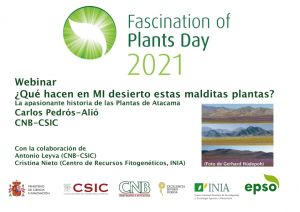
El Departamento de Genética Molecular de Plantas del CNB-CSIC ha consolidado su participación para conmemorar este día mediante la realización de actividades divulgativas desde el año 2018. Desde charlas divulgativas a cargo de investigadores del Jardín Botánico o la Universidad Autónoma de Madrid a la organización de talleres sobre las aplicaciones biotecnológicas de las plantas para estudiantes de primaria y secundaria entre otras.
Este año contamos con la provocadora charla divulgativa “¿Qué hacen en MI desierto estas malditas plantas? a cargo de Carlos Pedrós-Alió, profesor de investigación en el CNB-CSIC y experto en ecología y diversidad de microorganismos que viven en lugares extremos. Carlos acaba de publicar el libro “Las Plantas de Atacama. El desierto cálido más árido del mundo”, resultado de sus viajes de investigación a este desierto a lo largo de mas de 20 años. Estos viajes, originalmente organizados para conocer los microorganismos de esa región, le han permitido observar que también las plantas han sido capaces de adaptarse a vivir en esos lugares extremos, compitiendo con microorganismos. En esta charla nos guiará por El Desierto de Atacama, para conocer mejor sus flores y plantas hasta que podamos viajar de nuevo a lugares maravillosos como este.
La charla se realizará online a través de nuestro canal de Youtube el próximo 18 de mayo a las 4 de la tarde. El registro ya está abierto en nuestra web
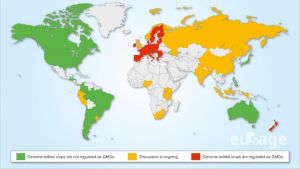
La edición genómica es una tecnología revolucionaria y cuya trascendencia ha sido reconocida con la concesión del premio Nobel a sus descubridores. Su aplicación a la mejora de cultivos trasciende al ámbito de la investigación.
La edición genómica es una nueva aproximación a la mejora genética basada en el conocimiento, que aprovecha las propias soluciones naturales de las plantas, y puede utilizarse paraa reducir los actuales requerimientos de insumos externos y haciendo posible una producción de alimentos más respetuosa con el medio ambiente.
La decisión del Tribunal de Justicia de la UE de someter las plantas mejoradas mediante edición genómica a la complicada y costosa regulación europea sobre Organismos Modificados Genéticamente (OMG) coloca a esta tecnología fuera del ámbito habitual de obtención y registro de variedades vegetales.
Esto supone un duro varapalo a las expectativas y promesas que la edición genética ofrece para la sostenibilidad y la competitividad de un sector como el agroalimentario, que tanta importancia tiene en nuestro país.
Las numerosas reacciones a esta sentencia han llevado a la UE a realizar un estudio sobre su importancia y su impacto en el seno de la Unión.
El CNB se une a las numerosas voces académicas y empresariales que reclaman una revisión de dicha legislación, de manera que no restrinja las enormes oportunidades que estas técnicas pueden aportar a la agricultura española y europea, incidiendo en la necesidad de crear unas condiciones favorables, basadas en la evidencia científica, para el desarrollo óptimo de la producción vegetal.
En este sentido, el CNB se une y apoya la carta lanzada por EUSAGE (European Sustainable Agriculture through Genome Editing), donde la comunidad científica representada por EU-SAGE señala la necesidad de que el estudio de la UE promueva un estatus regulatorio proporcionado y no discriminatorio para los cultivos mejorados mediante edición genética en la legislación europea, y que permita el desarrollo y la introducción en el mercado europeo de los cultivos con genomas editados.
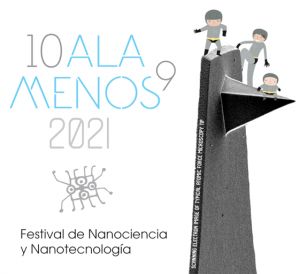
Desde el año 2017, varios centros e institutos del CSIC ubicados en la Comunidad de Madrid participan en el Festival de Nanociencia y Nanotecnología, nacido en 2016 y coordinado a nivel internacional por la Universidad de Barcelona.
En este Festival se celebran un gran abanico de actividades dirigidas a públicos muy diversos, con el fin de acercar a la sociedad los descubrimientos en el campo de la nanociencia, así como sus aplicaciones en nanotecnología. La Delegación Institucional del CSIC en la Comunidad de Madrid y el Instituto de Micro y Nanotecnología (IMN-CNM) del CSIC, coordinan las actividades que diferentes institutos del CSIC en la Comunidad de Madrid van a organizar y cuya información podéis encontrar aquí
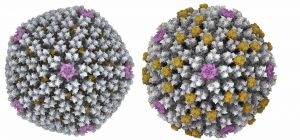
Scientists from the Spanish National Research Council (CSIC), the Autónoma University in Madrid (UAM) and the Pasteur Institute in France have solved for the first time the high resolution structure of an atadenovirus, a type of adenovirus that infects lizards. Until now, the only adenovirus structures known belonged to adenoviruses that infect mammals, although there are more than 200 adenoviruses that can infect other species and would have a potential therapeutical use as alternative vectors in the development of vaccines or gene therapy treatments.
This new high-resolution viral structure, published in Science Advances by Carmen San Martín group at the National Centre for Biotechnology (CNB-CSIC), shows an important difference in the surface of the atadenovirus capsid: the presence of a protein called LH3 that does not exist in the human adenovirus, but whose capsid anchoring domain is structurally identical to that of human adenovirus protein IX, despite the fact that both proteins have a completely different sequence. For San Martín, "the fact that both viruses evolve to preserve a specific structure reveals its importance for the formation and global maintenance of the capsid, and therefore the survival of the virus." "In addition, there is another part of LH3 that resembles the E1B-55K protein of human adenoviruses, which is not part of the capsid, but rather interferes with the cell division cycle."
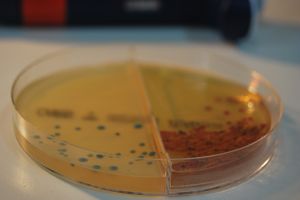
El nuevo trabajo del grupo de Álvaro San Millán, investigador del Consejo Superior de Investigaciones Científicas (CSIC) en el Centro Nacional de Biotecnología (CNB-CSIC), en colaboración con el Instituto Ramón y Cajal de Investigaciones Sanitarias (IRYCIS) y la Universidad de Oxford ha realizado la caracterización epidemiológica y genética de las bacterias intrahospitalarias que transmiten nuevas resistencias frente a antibióticos.
La propagación de los mecanismos de resistencia a antibióticos de mayor relevancia clínica entre patógenos bacterianos se debe fundamentalmente al intercambio de información genética extracromosómica entre bacterias. Estas moléculas de ADN, llamadas plásmidos, se multiplican de manera autónoma y se transmiten de forma independiente del ADN cromosómico. Los resultados de esta investigación publicada en Nature Microbiology apuntan a la importancia de los plásmidos en la diseminación de mecanismos y genes de resistencia a antibióticos de nueva generación que se utilizan en entornos hospitalarios entre las enterobacterias. Estas infecciones constituyen una de las principales amenazas para los pacientes hospitalizados, especialmente en las unidades de cuidados intensivos (UCIs), donde los pacientes ancianos e inmunodeprimidos son sometidos a procedimientos invasivos, que facilitan la colonización bacteriana.
COOKIES POLICY
A cookie is a text file that is stored on your computer or mobile device via a web server and only that server will be able to retrieve or read the contents of the cookie and allow the Web site remember browser preferences and navigate efficiently. Cookies make the interaction between the user and the website faster and easier.
General information
This Website uses cookies. Cookies are small text files generated by the web pages you visit, which contain the session data that can be useful later in the website. In this way this Web remembers information about your visit, which can facilitate your next visit and make the website more useful.
How do cookies?
Cookies can only store text, usually always anonymous and encrypted. No personal information is ever stored in a cookie, or can be associated with identified or identifiable person.
The data allow this website to keep your information between the pages, and also to discuss how to interact with the website. Cookies are safe because they can only store information that is put there by the browser, which is information the user entered in the browser or included in the page request. You can not run the code and can not be used to access your computer. If a website encrypts cookie data, only the website can read the information.
What types of cookies used?
The cookies used by this website can be distinguished by the following criteria:
1. Types of cookies as the entity that manages:
Depending on who the entity operating the computer or domain where cookies are sent and treat the data obtained, we can distinguish:
- Own cookies: are those that are sent to the user's terminal equipment from a computer or domain managed by the editor itself and from which provides the service requested by the user.
- Third party cookies: these are those that are sent to the user's terminal equipment from a machine or domain that is not managed by the publisher, but by another entity data is obtained through cookies.
In the event that the cookies are installed from a computer or domain managed by the editor itself but the information collected by these is managed by a third party can not be considered as party cookies.
2. Types of cookies as the length of time that remain active:
Depending on the length of time that remain active in the terminal equipment can be distinguished:
- Session cookies: cookies are a type designed to collect and store data while the user accesses a web page. Are usually used to store information that only worth preserving for the service requested by the user at any one time (eg a list of products purchased).
- Persistent cookies: cookies are a type of data which are stored in the terminal and can be accessed and treated for a period defined by the head of the cookie, and can range from a few minutes to several years.
3. Cookies types according to their purpose:
Depending on the purpose for which the data are processed through cookies, we can distinguish between:
- Technical cookies: these are those that allow the user to navigate through a web page or application platform and the use of different options or services it exist as, for example, control traffic and data communication, identify the session, access to restricted access parts, remember the elements of an order, make the buying process an order, make an application for registration or participation in an event, use security features while browsing store content for dissemination videos or sound or share content via social networks.
- Customization cookies: these are those that allow the user to access the service with some general characteristics based on a predefined set of criteria in the user terminal would eg language, the type of browser through which you access the service, the locale from which you access the service, etc.
- Analysis cookies: they are those that allow the responsible for them, monitoring and analyzing the behavior of users of the web sites that are linked. The information gathered through such cookies are used in measuring the activity of web sites, application or platform and for the profiling of user navigation of such sites, applications and platforms, in order to make improvements function data analysis how users use the service.
Management tool cookies
This Website uses Google Analytics.
Google Analytics is a free tool from Google that primarily allows website owners know how users interact with your website. Also, enable cookies in the domain of the site in which you are and uses a set of cookies called "__utma" and "__utmz" to collect information anonymously and reporting of website trends without identifying individual users..
For statistics of use of this website use cookies in order to know the level of recurrence of our visitors and more interesting content. This way we can concentrate our efforts on improving the most visited areas and make the user more easily find what they are looking for. On this site you can use the information from your visit for statistical evaluations and calculations anonymous data and to ensure the continuity of service or to make improvements to their websites. For more details, see the link below privacy policy [http://www.google.com/intl/en/policies/privacy/]
How to manage cookies on your computer: disabling and deleting cookies
All Internet browsers allow you to limit the behavior of a cookie or disable cookies within settings or browser settings. The steps for doing so are different for each browser, you can find instructions in the help menu of your browser.
If you decline the use of cookies, since it is possible thanks to the preferences menu of your browser or settings, reject, this website will continue to function properly without the use of the same.
Can you allow, block or delete cookies installed on your computer by setting your browser options installed on your computer:
- For more information about Internet Explorer click here.
- For more information on Chrome click here.
- For more information about Safari click here.
- For more information about Firefox click here.
Through your browser, you can also view the cookies that are on your computer, and delete them as you see fit. Cookies are text files, you can open and read the contents. The data within them is almost always encrypted with a numeric key corresponding to an Internet session so often has no meaning beyond the website who wrote it.
Informed consent
The use of this website on the other hand, implies that you paid your specific consent to the use of cookies, on the terms and conditions provided in this Cookies Policy, without prejudice to the measures of deactivation and removal of cookies that you can take, and mentioned in the previous section.